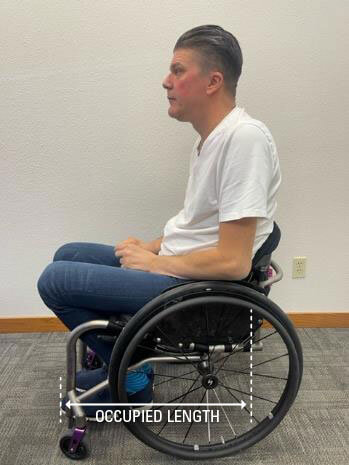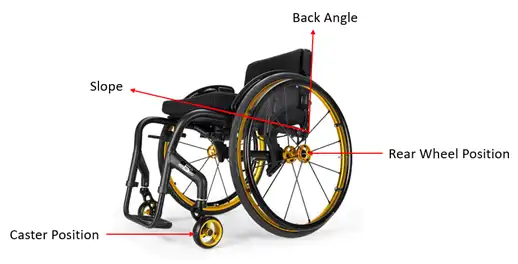During the 2023 International Seating Symposium preconference, members of the Sunrise Medical clinical education team joined forces with other manufacturers to present "Ultra Lightweight Wheelchair Prescription: The Importance of Getting It Right" (Pedersen et al.). The speakers included Jessica Presperin Pedersen, Sarah Leonard, Christie Hamstra, Erin Maniaci, Tricia Garven, Curt Prewitt, and Debbie Pucci. The presentation focused on personalizing wheelchair configuration to optimize posture, propulsion, and function.
The configuration of the wheelchair is unique to each person with the goal of providing postural support to enhance stabilization of the pelvis. This allows for optimal positioning of the shoulders for propulsion while taking into consideration both center of mass and center of gravity. Occupied frame length is the measurement from inside the backrest tube to the front edge of the foot support.
 Occupied frame length
Occupied frame length
The consensus of the presenters is that the following configurations can positively affect weight distribution, which can enhance posture and propulsion:
- Rear wheel position - including fore and aft or vertical position
- Seat slope - the difference between front and rear seat-to-floor height
- Caster position - determined by seat depth, frame length, front frame angle
- Back angle - the vertical position of the backrest relative to the floor, determined by frame or commercial back support hardware

Furumasu & McNitt Research on Wheelchair Configuration
The work of Jan Furumasu Lewis, PT at Ranchos Los Amigos National Rehabilitation Center, and Dr. Jill McNitt-Gray, PhD at the University of Southern California Viterbi School of Engineering, were critical in providing evidence demonstrating the benefits of personalized manual wheelchair configuration.
In a study of 28 persons with spinal cord injury, adjustments were made to the wheelchair based on rider and therapist input. The hypothesis was that the adjustments would affect wheelchair stability, posture, and shoulder loading. Measurements included videos of inertia, force on the push rim using the Smart Wheel, and surveys including PROMIS, WUSPI, RNCI, and the WHOM. Measurements were taken before the changes, immediately after the changes, and one month after the changes were incorporated into the wheelchair.
Furumasu Lewis shared that riders participating in the research were found to be using adjustable ultralight rigid wheelchairs that were initially not adjusted to their optimal configuration. Some of the riders had changed in their functional and postural abilities, while others may not have been fitted properly during their delivery fitting. Using their clinical expertise and outcome measures, adjustments were made based on findings and the goal of optimizing posture and propulsion techniques. Adjustments included changing the seat-to-back angle, moving the rear wheel fore & aft, and changing the seat slope.
Findings included:
- 15/28 participants had changes made to the seat-to-back angle, with 12/15 moving the back more vertical.
- 10/28 participants had the rear wheel axle moved either fore or aft, with 9/10 moving the rear wheel forward.
- 18/28 participants had changes in seat slope, with seat slope increasing more if the person had more involvement for increased stability.
Furumasu Lewis et al. analyzed and narrated the videos taken at baseline, after changes, and one month post-intervention. Their research and videos can be found on the Ranchos Los Amigos National Rehabilitation Hospital website.
Translating Evidence into the Clinic
The results of this research illustrate what the clinical educators demonstrated during the workshop. Clinical experience and observation, combined with rider input, has provided evidence-based practice to guide manufacturers in the design and fabrication of optimal ultra lightweight rigid wheelchairs. But research, incorporating a methodology using objective outcomes, adds scientific evidence to justify the configurations presented in the workshop.
Members of Sunrise Medical's Clinical Education Team, Jessica Presperin Pedersen and Sarah Leonard, wish to thank Jan Furumasu Lewis and Jill McNitt-Gray for their work on the "Effect of Personalized Wheelchair Configuration on Upper Extremity Mechanics During Wheelchair Propulsion" and allowing us to share their results with participants at the 2023 ISS preconference.
References
- Furumasu J., McNitt-Gray J.L., Wiens C., Russell I., & Requejo P.S. (2020). Effect of Personalized Wheelchair Configuration on Upper Extremity Mechanics During Wheelchair Propulsion. Proceedings International Seating Symposium.
- Presperin Pedersen J., Leonard S., Hamstra C., Maniaci E., Garven T., Prewitt C., & Pucci D. (2023). Ultra Lightweight Wheelchair Prescription: The Importance of Getting It Right. International Seating Symposium 2023 Pre-Conference.
With over 40 years of clinical practice as an OT, Jessica Presperin Pedersen has worked in all sectors of the wheelchair and seating industry as a master clinician, supplier, manufacturing consultant, design representative, and educator. Dr. Presperin Pedersen was a pioneer in the development of the profession of wheelchairs and seating in the 1980s and has spent the last two decades contributing to the research world to demonstrate evidence for knowledge translation in the clinic, advocacy, and product development. She is a RESNA and AOTA Fellow, serves on the Clinician Task Force, the Seating and Wheeled Mobility Committee for AOTA, and has shared her experiences internationally through publications and presentations.